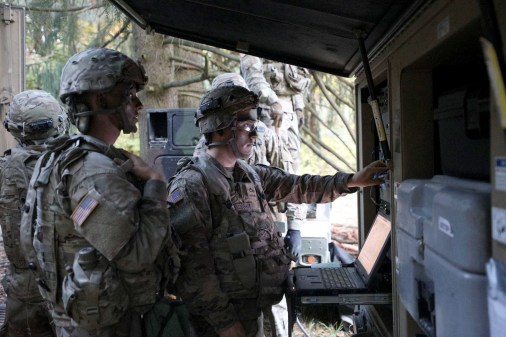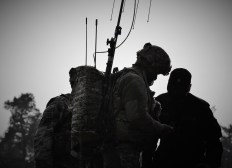Even as it struggles to define what it will look like and how it will operate in the post-Afghanistan era, the U.S. Army is also grappling with a potentially devastating financial decision — how to best balance funding for readiness, force structure and modernization.
Across-the-board budget cuts required under sequestration have forced the Army to begin making difficult choices about how it will organize itself and ensure the best, most practical technologies can be integrated into Army operations in a timely fashion. But the bottom line for many senior Army leaders who spoke this week at the Association of the U.S. Army Annual Meeting in Washington, D.C., is that the Army is getting smaller, the budget is shrinking dramatically and there will be significant risk attached to the service’s future readiness and modernization efforts.
“We don’t see an end in sight,” said Lt. Gen. James Barclay, the Army’s deputy chief of staff for programming and analysis (G-8). “We’re going to have some tough times [between 2015 – 2019], where we are going to take some risk in our modernization and readiness.”
Readiness and modernization are of particular concern to senior Army leaders because the service can’t simply reduce the number of soldiers overnight without incurring major costs and jeopardizing its ability to respond to major national security crises. This year, the Army will reduce its size to about 520,000 soldiers, with a target of 420,000 by FY 2015, Barclay said.
One of the major questions facing Army planners as they begin to implement the service’s new strategic force structure — Regionally Aligned Forces — is to what extent will the Army rely on private industry or its own laboratories to produce innovations to modernize everything from tanks and helicopters to individual soldier situation awareness capabilities.
“We’re talking about whether we’re technology makers or technology takers,” Barclay said, acknowledging the military has serious problems with its acquisition timelines and ability to field new innovations quickly before they become obsolete.
“We do have challenges when it comes to our acquisition process, but I’ll also tell you it’s a two-way street,” Barclay said. “Even if we were able to solve [the time-to-deployment problem] … the other aspect to that is if you don’t have predictability in any funding profiles, you cannot go forward to make things happen. You’ve got to have flexibility. Without some flexibility [in funding], you cannot go out and take some risk.”
Robie Samanta Roy, a professional staff member on the Senate Armed Services Committee, said he worries particularly about the military’s ability to attract the best and brightest engineers and IT professionals to ensure the ability to keep pace with the speed of innovation.
“We worry about innovation,” Roy said. “And innovation in my mind has two components: One is the sophistication of your technology, but it’s also the speed of innovation.”
Another big issue is the Army’s current science and technology infrastructure. The Army has roughly 1,100 facilities in its S&T enterprise. But “anywhere from about a third of them fall within a category where there is a significant negative impact to their mission,” Roy said.
The real danger, however, is the “permanent loss of capability” the Army may experience as these short-term decisions are made on tradeoffs, said Kevin Gates, a professional staff member on the House Armed Services Committee. And the Army has already “gone well past cutting fat and cutting into muscle and bone, into core capabilities,” Gates said. “We’re not going to see the effects of that until, unfortunately, it’s too late.”
Making matters worse for the Army and the Defense Department as a whole is the inability of the military establishment to act as an early adopter of disruptive technologies.
“The big problem is the Army and the Department of Defense is not flexible enough to be adaptive to the changing environment,” Gates said. “The acquisition regulations and the directives that are out there sort of conspire against the Army or the department or any of the other services from really being edge adopters of almost any technology.”
And there are many disruptive technologies on the horizon that could enable a smaller Army to be more capable, flexible and smarter, said Angela Messer, an executive vice president at Booz Allen Hamilton. But the current thinking in industry is to look beyond baseline cloud, big data, mobile and social capabilities, to more disruptive IT, she said.
From the soldier’s perspective, there are emerging physical and cognitive technologies for assessing performance, fatigue and learning, Messer said.
“Some of the ubiquitous, inexpensive sensors that are already out there, such as health monitors, are not only getting smaller and miniaturized, [but are] allowing soldiers to wear them or ingest or inject them into their bodies,” Messer said.
There is also an emerging set of technologies that can detect sentiment in text and voice, as well as emotion. This would allow senior leaders to understand the “emotional psyche” of a soldier in battle, Messer said.
From a logistics and force sustainment perspective, 3-D printing could be another game-changer. “If you think about 3-D printing on steroids, you can imagine…impacting our logistics systems to include modernization right there on the frontlines,” Messer said.
Messer also pointed to current research into driverless cars as a potential life-saving technology for the Army. Research currently being done by the likes of Google and other companies could one day produce Army vehicles capable of signaling other vehicles in a convoy automatically when it encounters a pothole or roadside threat, enabling other vehicles to automatically adjust security mechanisms, like seatbelts.
“The ability to connect the data and the sensors that are now on these vehicles I think is going to have an impact on the ability of the military to do business and save lives,” Messer said.
But the Army has to get better at its ability to identify disruptive technologies and then deploy them. And that’s not as easy as it sounds, Gates said.
“One thing that we don’t do very well in the government is think about the policy and ethical implications of the technology as it’s being developed,” Gates said. “It’s almost always a response to something coming online. So thinking about the use of human performance augmentation for soldiers or to use social media analytics to improve intelligence analysis, they don’t surprise anybody in industry. But when the rubber meets the road and the [Pentagon] starts thinking about adopting these technologies, they start to realize the second and third order effects that no one ever considered.”
Those second and third order effects Gates referred to often involve impacts on organization, tactics and policy.
For Heidi Shyu, the assistant secretary of the Army for Acquisition, Logistics and Technology, modernization funding is directed specifically at capabilities that have obvious merit and potential to solve a real Army problem. But when it comes to taking risks in modernization and adopting disruptive technologies, larger government issues can often become the real obstacles, she said.
“A lot of the statutory and regulatory responsibility that’s imposed upon acquisition is not exactly of our own making,” Shyu said. “Having been in the government for three years and 33 years in industry, I am utterly shocked — utterly shocked — how little control the poor [program manager] has. I thought the PM had a lot of control over his program. The PM is a flea on the tail of this dog.”
The inability of program managers to run their programs has left the job of defending the budget, particularly the science and technology budget, to the most senior leaders, like Shyu and Barclay.
“Everyone goes after your S&T first,” Barclay said. “It’s very hard to protect those S&T dollars. Those are dollars that are easy because you haven’t gotten anything from them yet. But S&T “really is the only way we can get through this.”






